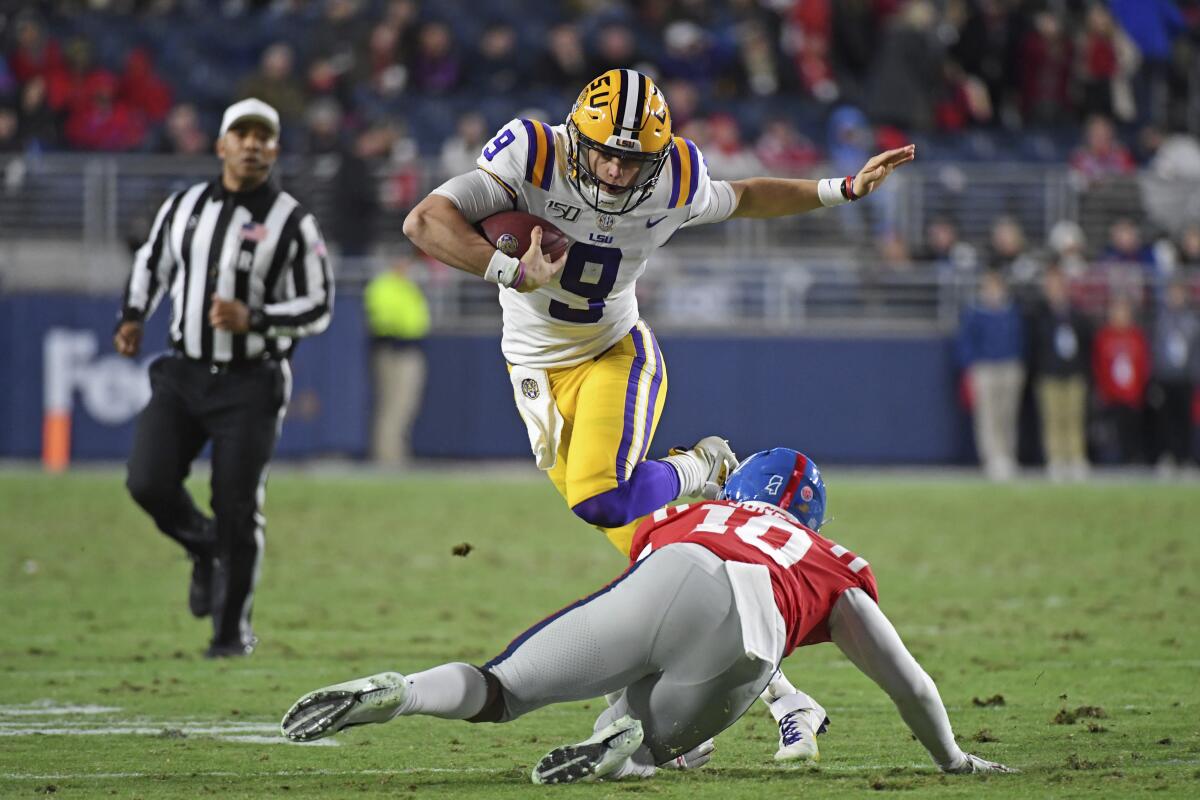Do college football programs that use cutting-edge technology have an unfair advantage?

- Share via
College football is crossing over to the high-tech gridiron age, a new era that could end up making competition unbalanced — in football and other sports — with technological-haves outstripping the have-nots. But the reality of this modern athletic age is far more nuanced than that.
Competition could not exist without opponents possessing advantages and disadvantages. If each team was theoretically equal, there would be almost no contest and each game would essentially end in a tie. As early 20th century American philosopher George Santayana wrote: “Equality in these respects would mean total absence of excellence.”
However, it is important to both competitors and observers that these advantages and disadvantages are regarded as fair, but determining what is fair is not easy.
As we head into the long Thanksgiving weekend, college rivalry games will be front and center. The advanced technology that helped coaches and players get ready for these games will be in the shadows.
As Louisiana State University’s football team prepares to go up against Texas A&M on Saturday, they have a new virtual reality room to simulate on-field scenarios — allowing players to interact with life-sized projections of an opposing team’s formations. Only two other universities, Michigan and Notre Dame, have this technology that gives new meaning to screening game films.
LSU’s $28-million football operations building that opened over the summer brims with high-tech gadgets and gizmos that include anti-gravity treadmills for improved injury rehabbing and neuroimaging headgear that tracks brain functions of athletes as they train.
Players at Clemson University may be preparing to face longtime rival University of South Carolina on Saturday by correcting their form using motion-capture technology, which has roots in early 20th century animation. Or they may be rehabilitating sore muscles in the school’s sensory-deprivation tank or its $60,000 cryotherapy chamber.
The sports teams at schools that pioneer these technologies may be the first to benefit from the advantages they could bring. But early adopters also run the risk of wasting time and resources on technology that ends up not being effective or beneficial. For instance, researchers have questioned whether those expensive cryotherapy chambers benefit recovery.
Technology could end up helping balance some inequities between schools by improving recruiting. Potential college athletes might seek out a school with a multimillion-dollar sports lab because they think it will help them improve their skill set, keep them healthier — and help them go pro. Investing in technology could help a lesser-known or smaller school recruit more elite high school athletes.
Yet some top high school athletes might prefer an old-school approach that focuses on fundamentals, which might give colleges that haven’t invested in advanced technology an unexpected recruiting advantage.
If the technology works as advertised, teams heavily invested in it will likely have an advantage on game day, especially if their athletes are healthier and better prepared to play. The moral question is whether that is an unfair advantage.
The problem is that we use “fair” in different and sometimes conflicting ways.
A common reason we think something is unfair is when a choice doesn’t follow the rules or the rules are not applied impartially. It is unfair when one team is allowed to commit pass interference while the other team is penalized. But it is not against NCAA rules for Clemson to use motion-capture technology to analyze player movements even though its opponent might not.
Similarly, it might seem unfair for West Virginia University players to benefit from pricey cryotherapy chambers that could benefit rehabilitation when players at some schools they might compete with must try to soothe their muscles the old-fashioned way — by immersing themselves in ice baths set up in trash cans.
At first, only the best-funded programs can bring this technology into their facilities since the equipment and the costs to start and run research labs to manage the technology can be prohibitively expensive.
If the tech succeeds in helping teams improve on the field, then schools without major research labs or deep-pocketed donors to pay for such technological bells and whistles will lag behind. In real time, that seems unfair.
But inequity has been part of college football since the first intercollegiate game was played 150 years ago this month between Rutgers and Princeton universities. So many other things come into play beyond financial resources when it comes to competition and advantages — such as whether a team plays in warm or cold climates, how easy it is for a college to recruit and how much academic support is in place to help student athletes succeed off the field.
In the long run, early adopters end up helping the schools that can’t afford to go high-tech because the technology that works well invariably becomes more widely adopted and less expensive — and more available to programs that otherwise couldn’t have afforded it. That sounds fair to me.
Shawn E. Klein teaches philosophy and sports ethics at Arizona State University. He blogs at sportethicist.com.
More to Read
A cure for the common opinion
Get thought-provoking perspectives with our weekly newsletter.
You may occasionally receive promotional content from the Los Angeles Times.









